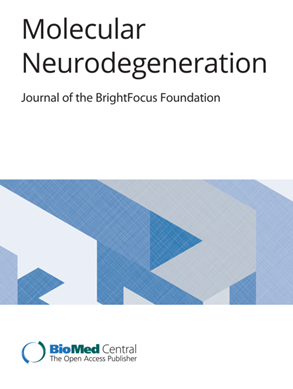Age-dependent progression from clearance to vulnerability in the early response of periventricular microglia to α-synuclein toxic species
IF 17.5
1区 医学
Q1 NEUROSCIENCES
引用次数: 0
Abstract
Cytoplasmic alpha-synuclein (αSyn) aggregates are a typical feature of Parkinson’s disease (PD). Extracellular insoluble αSyn can induce pathology in healthy neurons suggesting that PD neurodegeneration may spread through cell-to-cell transfer of αSyn proteopathic seeds. Early pro-homeostatic reaction of microglia to toxic forms of αSyn remains elusive, which is especially relevant considering the recently uncovered microglial molecular diversity. Here, we show that periventricular microglia of the subependymal neurogenic niche monitor the cerebrospinal fluid and can rapidly phagocytize and degrade different aggregated forms of αSyn delivered into the lateral ventricle. However, this clearing ability worsens with age, leading to an increase in microglia with aggregates in aged treated mice, an accumulation also observed in human PD samples. We also show that exposure of aged microglia to aggregated αSyn isolated from human PD samples results in the phosphorylation of the endogenous protein and the generation of αSyn seeds that can transmit the pathology to healthy neurons. Our data indicate that while microglial phagocytosis rapidly clears toxic αSyn, aged microglia can contribute to synucleinopathy spreading.脑室周围小胶质细胞对α-突触核蛋白毒性物质的早期反应从清除到易损的年龄依赖性进展
细胞质α -突触核蛋白(αSyn)聚集是帕金森病(PD)的典型特征。细胞外不溶性αSyn可诱导健康神经元病变,提示PD神经变性可能通过αSyn蛋白致病种子的细胞间转移而扩散。小胶质细胞对αSyn毒性形式的早期促稳态反应仍然难以捉摸,考虑到最近发现的小胶质细胞分子多样性,这一点尤为重要。在这里,我们发现室管膜下神经源性生态位的脑室周围小胶质细胞监测脑脊液,并能迅速吞噬和降解递送到侧脑室的不同聚集形式的αSyn。然而,这种清除能力随着年龄的增长而恶化,导致老年小鼠小胶质细胞聚集物的增加,在人类PD样本中也观察到积累。我们还发现,将衰老的小胶质细胞暴露于从人PD样本中分离的聚集αSyn会导致内源性蛋白磷酸化,并产生αSyn种子,从而将病理传递给健康的神经元。我们的数据表明,虽然小胶质细胞吞噬作用可以迅速清除有毒的αSyn,但衰老的小胶质细胞可以促进突触核蛋白病的扩散。
本文章由计算机程序翻译,如有差异,请以英文原文为准。
求助全文
约1分钟内获得全文
求助全文
来源期刊

Molecular Neurodegeneration
医学-神经科学
CiteScore
23.00
自引率
4.60%
发文量
78
审稿时长
6-12 weeks
期刊介绍:
Molecular Neurodegeneration, an open-access, peer-reviewed journal, comprehensively covers neurodegeneration research at the molecular and cellular levels.
Neurodegenerative diseases, such as Alzheimer's, Parkinson's, Huntington's, and prion diseases, fall under its purview. These disorders, often linked to advanced aging and characterized by varying degrees of dementia, pose a significant public health concern with the growing aging population. Recent strides in understanding the molecular and cellular mechanisms of these neurodegenerative disorders offer valuable insights into their pathogenesis.
 求助内容:
求助内容: 应助结果提醒方式:
应助结果提醒方式:


